Photos with this report (click to enlarge) | |||
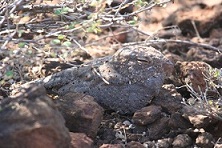 Star-spotted Nightjar |
 Northern White-faced Owl |
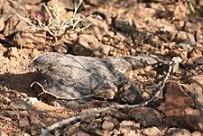 Star-spotted Nightjar |
|
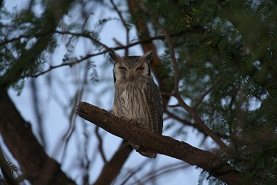 Northern White-faced Owl |
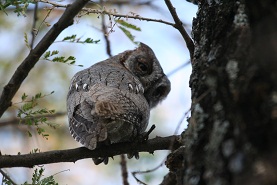 African Scops-Owl |
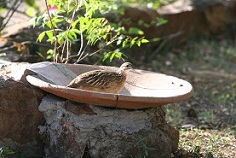 Crested Francolin |
|
Francis is a well-known guide and night-birds whizz at Lake Baringo. He had joined me a bit earlier for an (unsuccessful) attempt at Somali Sparrow a little further north at Kapedo (see http://www.nation.co.ke/magazines/saturday/Sojourn%20in%20Gods%20country%20/-/1216/950948/-/view/printVersion/-/bxdkrz/-/index.html). During that trip, he mentioned that a pair of Star-spotted Nightjar visited the Baringo area every year in December and January. In fact, they turned up a bit earlier than expected – he got in touch, and I drove up from Nairobi (about 300km on paved roads, mostly good condition) the following weekend after getting the call, arriving about noon on the Saturday. James Wawire joined me – he also hadn’t seen this species, which is difficult in Kenya and probably also in Ethiopia (the only other place you are likely to see it)—and in Kenya mostly found in the more remote, northern parts of the country.
The two main resorts in this area – Lake Baringo Club and Roberts Camp – are adjacent to each other on the lakeshore. We met Francis on the main road just before the resort area. Baringo is at a much lower altitude than the more southern Rift lakes, it’s on the fringes of the desert, and away from the Lake it is bare ground and short acacia trees—Francis directed us to a nearby area that was perhaps more open and stony than the rest, and quickly pointed out the pair of visiting nightjar, as well as a larger, much more patterned roosting Slender-tailed Nightjar, which is the common nightjar species in this area.
We had a lively debate the rest of the day about the identification. A bird tour that had visited the previous day had tended towards calling one of them Star-spotted and the other Nubian, but to me the proportions looked identical and, based on what I could find in books, a good bet for Star-spotted. One of them had the star-shaped spots on the mantle and crown. Both were small and plain coloured, with proportionally large heads and short, slightly tapered tails, neither of which showed any white at rest. As far as I can tell, the only feature arguing against Star-spotted was the rather limited amount of white on the neck. For the similar species, the books I’ve looked at show Freckled as dark (which neither of these were), Nubian with extensive rufous and silvery grey, and both Nubian and Plain (the latter probably the most similar to Star-spotted—it is apparently also variable and can have star-shaped spots) have relatively long tails, with extensive white in the tail of male Plain Nightjar. I have attached photos of both individuals we saw, so you can have your own view.
On the way back to the resort, Francis stopped off at a spot where three Northern White-faced Owls were roosting, high up in a larger acacia tree. At rest, they have an amazing cryptic posture, a bit like a frogmouth or a potoo. In the evening, we went for a walk around the lakeshore in the Roberts Camp and Baringo Club grounds, with flocks of Little Weavers in flowering trees. Amazingly, Francis located another roosting White-faced Owl, a roosting African Scops in a small tree behind the Baringo Club cabins, and whistled in a Pearl-spotted Owlet for good measure. About 6pm, we drove back to the nightjar site in the hope of hearing them calling (and perhaps getting a recording) but both had left. In fact, despite seeing numerous nightjars that night, we didn’t hear any calling – this seems to be the quiet time of year, so it is likely the Star-spotted are a non-breeding visitor to this area – possibly a local migrant. After failing at the roosting site, Francis took us to the Baringo airstrip, where we drove around flushing Slender-tailed Nightjar (as well as hares and some nocturnally active sparrow-larks)—we also saw a smaller nightjar but it flew off too far, and in any case none were calling so it wouldn’t have given us any more evidence.
Since Robert Camp was full, we stayed the night at the nearby Tamarind Hotel, 1,000 KSh for a single room and 1,800 for a double. The food was good, but we travelled back to Roberts Camp early for breakfast the next morning, since the restaurant there is one of the best places to see birds. Jackson’s Hornbill and several species of barbet (Red-and-yellow, D’Arnaud’s and Red-fronted) can often be seen nearby, and the weaver flocks that morning included a male Northern Masked with a ring. Perhaps even better, we were distracted from our food by a pair of Wahlberg’s Honeybirds that flew into a nearby tree, and after chasing them from tree to tree for a matter of seconds, came back to find about 30 Superb Starlings helping themselves to toast and jam.
The final stop was the nightjar site again, and both were back to their roosting spot (although in slightly different places) and the lone Slender-tailed was still there too.
If you are interested in contacting Francis, who speaks good English, his number is +254-(0)723-163267.
James Wawire (jwawire@birdingsafarisafrica.co.ke) also operates “Birding Safaris Africa ”— you can contact him if you want to include Baringo on an itinerary covering a lot of sites. James is also in touch with the Kenyan birding community and may be able to find spots for a lot of rare Kenyan birds (e.g., his colleagues one successful organized a trip for me to see Friedmann’s Lark in Shaba), and I have to thank him for putting me in touch with Francis and for the good company during the trip.